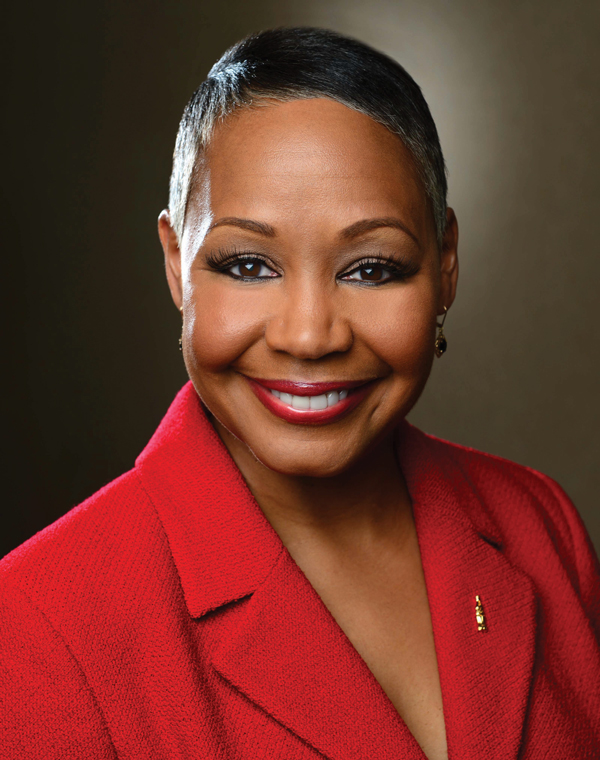
Photograph courtesy of the WNBA
In January 2008 the WNBA unveiled its first women’s pro team in Atlanta: the Dream. The basketball team became a reality largely due to the efforts of a group of boosters led by then City Council President Lisa Borders. Eight years later the former mayoral candidate and self-described “raving” WNBA fan has landed a dream gig—league president.
The WNBA enters its 20th season in May, and Borders needs to prove that the league can endure for decades more. “There’s still substantial work to be done,” she says. “We want to see increased attendance, better television ratings.” Last season Dream co-owners Mary Brock and Kelly Loeffler saw the team draw an average of just 6,122 fans to the 18,200-seat Philips Arena, making their games the fourth-least-attended in the WNBA. (By contrast, the Hawks averaged 17,412 fans a night.)
Just weeks into the job, Borders is still working on a strategy for growth, though she notes that “the NBA is 70 years [old]. If you go back to the 20th anniversary of any sports league, you’ll see that it’s taken substantially longer [than that] to go mainstream.”
Borders recently spoke with us about the becoming the WNBA’s president, growing the league, and her love for the Dream (and other teams).
You played a pivotal role in bringing the Dream to Atlanta. How did the president’s gig come about?
[Former WNBA President] Donna Orender’s pitch was to bring a team to the Atlanta market. It was about bringing a franchise to a city with a substantial amount of colleges—Atlanta University Center to Georgia State and Georgia Tech to Kennesaw State—[and] I had the privilege of taking that meeting with A.J. Robinson [of Central Atlanta Progress]. Fast forward to a luncheon, the keynote speaker was Madeleine Albright, who [said] that “there’s special place in hell for women who don’t support other women.” It resonated with me. I picked up the phone and called Stacey Abrams, the [current] House minority leader, [and others] and said, “We’re bring a team to Atlanta. You’ve got to help.” I was primarily responsible with finding an owner and raising the capital. We got our hands dirty and learned the league from the ground up.
[Then] on December 4, 2015 I was at a [Duke University board of trustees] meeting with NBA Commissioner Adam Silver. We talked about basketball, Duke basketball, the NBA, and the WNBA. What I realized is that I’ve always have taken on opportunities where I’ve carried the torch for folks who’ve not always had a full voice or had their voices not heard. In this instance, it was women. I’ve recently done that for the LGBT community at Coca-Cola. I’ve done it for the medically indigent at Grady Health Foundation, where I helped raised $325 million [to prevent a shutdown]. I’ve supported women at Coca-Cola through charitable giving. But this is a chance to take it to a whole other platform. At Coca-Cola I supported women globally. Basketball allows us to do that as well.
As the WNBA enters its 20th season, how do you feel about the job your predecessors have done? Where do you hope to take the WNBA next?
Each of my predecessors had an instrumental role in ensuring that today’s league would be the longest-standing and most successful women’s professional sports league in the country. Having said that, there’s still substantial work to be done that says we can endure. The next iteration of the league will say: “We can be sustained.” Our primary opportunity is to expand and grow the business. My predecessors have laid a firm foundation for the league staff, all the stakeholders—the owners, the coaches, the players, the fans—to build on. We’re going to grow the fan base. We want to see our attendance numbers increase. We want to see better television ratings. We want to see increased merchandise sales as well as more volume on our online traffic. The fundamentals, if you will.
How do you do that with a league that’s struggled to reach a wider audience?
We haven’t been in existence nearly as long as our big brother, the NBA. The NBA is 70 years. We’re 20 years old. If you go back to the 20th anniversary of any league, you’ll see that it’s taken substantially longer to “go mainstream.” All the work that’s been done has created an awareness of not only women and their ability to play the sport, but also of how well the sport can prepare you for life.
We need to draw some parallels: The change from year one to year 20 shows dramatic [growth in] professionalism, in athletic talent. There’s no question we have 144 of the best athletes in the world. When you think about individual players, the opportunity to grow attendance and merch sales and TV is all driven by the ability to relate to our players. When you think about the slam-dunk or the three point contests, people are cheering for the NBA players because they know who they are, they know their talents on the courts, and they recognize the personalities off the court. We have done an extraordinary job of showing the product on the court. But the greatest opportunity might be to open up and show who our individual players are and that they have many more dimensions to their personality beyond their athletic prowess.
I’m a season ticket-holder as we speak. I know every one of the Dream players, where they went to college, and many of their stats. I look at [forward] Angel McCoughtry, who is just extraordinary; she went to the University of Louisville. So did Shoni Schimmel, our point guard. Shoni can shoot a three-point shot like nobody’s business. Angel can drive the lane as well as anybody and can steal the ball better than most; her hand is always in the passing lane. We have an opportunity to open up our players’ personalities and let fans relate to them—current fans and fans we anticipate having in the future. That’s how you increase attendance.
How did you become such a big fan of the WNBA?
I’m not a fan. I’m a raving fan. I have always been a student of the game. But what I realized in 2007 was that women were not on even footing with their male counterparts. Women who wanted to live out their dreams as professional athletes didn’t have that opportunity—not only in Atlanta but broadly in this country. The league is an opportunity for women to do extremely well who played ball in college. Basketball is very much like life. Basketball is a team sport; life should be a team sport.
Organized sports offer players the chance to develop deep skills that are fungible: the ability to build consensus, the establishment of a strong work ethic, you learn to lead, and you learn to follow. There are studies that show that women who play organized sports are more successful in business because they learn those skills at a very early age. They have honed them so they are recognizable when they’re in a different environment. There’s a clear connection between playing organized sports and women doing well in their lives. We may be helping 144 women every year, but that has tentacles far beyond the professional ranks. These women are role models. They’re paragons of health. They are moms, sisters, and daughters. They are pillars of the community. If they can garner skills and demonstrate them to other girls that those skills can be useful, that’s the right thing to do.
A version of this article originally appeared in our May 2016 issue under the headline “Living the Dream.”













